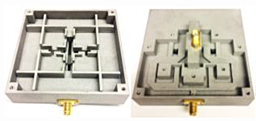Broadband, Low Profile, High Isolation, Two-Port Antenna for Radar and Communication Systems
TECHNOLOGY NUMBER: 2019-206

OVERVIEW
An antenna design that provides a high cancellation of self-interference- Allows for high isolation levels between channels over a bandwidth
- A wide variety of applications such as IoT hardware and electronic warfare
BACKGROUND
To alleviate the challenges faced by the ever-increasing demand for wireless communication, limited available bandwidth may be reused by enabling full-duplex communication. Full duplex wireless communication involves sending and receiving wireless signals at the same time and over the same frequency band. Using this approach, the current time-division duplex and frequency-division duplex transceivers can be replaced with full-duplex transceivers which can transmit and receive data over the same frequency band simultaneously, effectively doubling the channel capacity. This increase would prove important since the number of connected devices has multiplied exponentially because technologies such as the internet of things (IoT) have saturated the available channels within a frequency band. So, a need exists for newer methods to enhance channel capacity and permit continued growth of wireless communications.
INNOVATION
Researchers have invented a technology that improves antenna design and provides a high cancellation of self-interference which facilitates full duplex wireless communication. The advance is achieved through the formation of a novel geometry of a cavity-backed slot antenna which allows for better isolation between the transmitting and receiving antennas.
The antenna consists of a thin rectangular cavity appropriately loaded with metallic septa to excite multiple resonances of similar desired field distribution to achieve consistent radiation characteristics over a wide bandwidth. Four pairs of concentric orthogonal radiating slots are cut out on one of the broad-walls of the cavity all of which are fed by two concentric orthogonal slots on the opposite broad-wall of the cavity. The cavity is fed by an end-launch coaxial-to-waveguide transition to excite one of the channels. The other channel is excited by a two- pronged microstrip line symmetrically crossing over the other cavity feeding slot.
Due to the out-of-phase coupling from the two prongs of the microstrip line to the other port, this type of excitation is shown to provide an unpredicted level of isolation between the two channels over a wide bandwidth. To achieve a high-efficiency and fabrication accuracy of this complex architecture, the antenna is three dimensionally printed out of HP PA12 Nylon and is then metalized by silver spraying technology. The improvements afforded by this technology are relevant for a variety of applications such as hardware for the internet of things (IoT), electronic warfare, and 5G-enabled devices.
PATENT APPLICATION
Number: 62/850,600